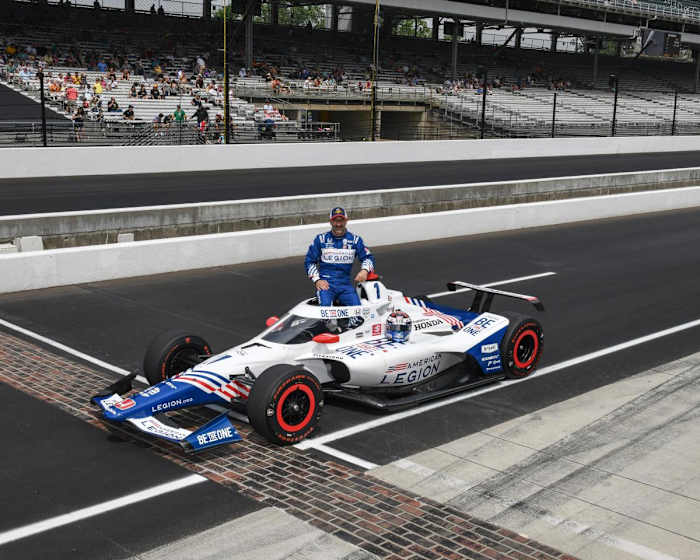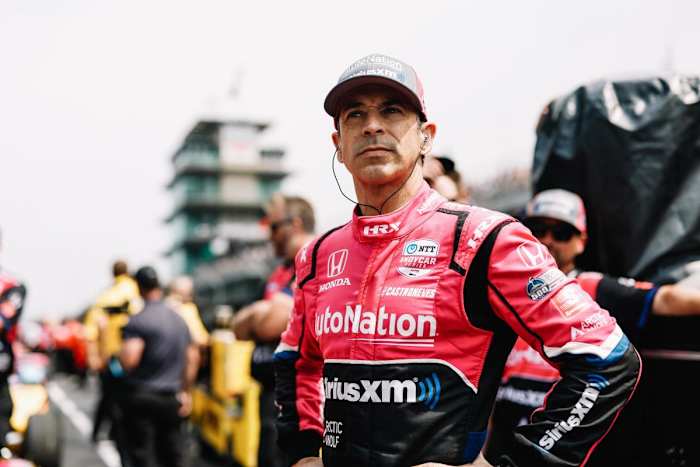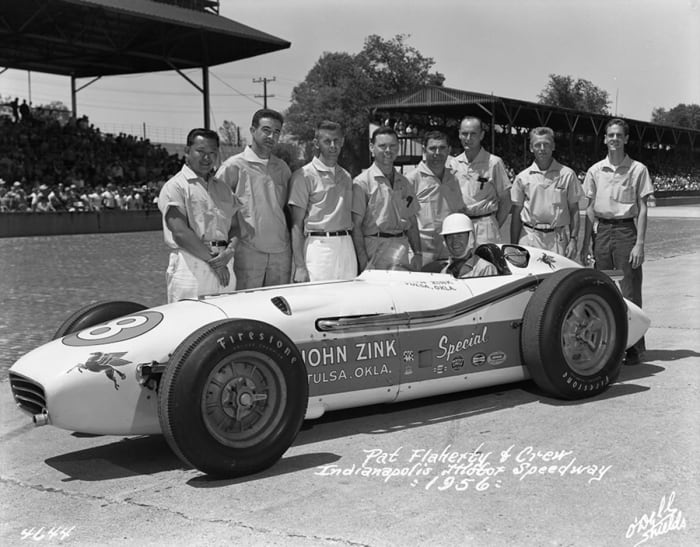
22 Things You May Have Missed From the 2022 Indianapolis 500

This year’s Indianapolis 500 had its share of drama, intrigue, and tradition, as the race usually does. It produced a first-time winner in Marcus Ericsson, marked a return to a full capacity crowd for the first time since 2019, and for the first time in 30 years, a driver was attempting to make history with his fifth Indianapolis 500 win.
But behind the headlines, are thousands of smaller stories and facts you may have missed. We have selected a few of our favorites to share with you while the postrace buzz is still high - we hope you enjoy!
So grab a cup of coffee or your favorite beverage, pull up a chair and enjoy some of the good, bad and ugly from Sunday’s 106th Running of the Indianapolis 500:
*******************************

Chip Ganassi in the 1982 Indianapolis 500. Photo courtesy Indianapolis Motor Speedway archives
Chip Ganassi in the 1982 Indianapolis 500. Photo courtesy Indianapolis Motor Speedway archives
- Marcus Ericsson’s win in the 2022 Indianapolis 500 for Chip Ganassi Racing marks Chip Ganassi’s fifth win as a car owner (2000 with Juan Pablo Montoya, 2008 with Scott Dixon, and 2010 and 2012 with Dario Franchitti). The win marks 10 years since Ganassi’s last Indy 500 win as a car owner, and occurred exactly 40 years after Ganassi’s first Indianapolis 500 appearance as a driver in 1982.
*******************************
2. Marcus became the first driver named “Marcus” to win the Indianapolis 500. The most popular first name? Al (or Alfred) has won the race 6 times (between Al Unser and Al Unser Jr.)
*******************************
3. No driver using a surname beginning with the letter “E” had ever won the race before Ericsson’s Sunday victory. The most common first letter in the surname of winners is R (14 times). No driver with a surname that starts with I, N, Q, X, Y or Z has ever won the race. (Note: These previous two stats consider names drivers have been known as professionally in their racing career, and may be different then their given/birth names in their native language. For example, Takuma Sato’s name in Japanese is 佐藤 琢磨, and Rinus van Kalmthout goes by Rinus VeeKay in his professional racing career.
*******************************
4. Ericsson joins a club of three former Formula 1 drivers to have won the Indy 500 in 5 of the last 8 races (Juan Pablo Montoya in 2015, Alexander Rossi in 2016, and Takuma Sato in both 2017 and 2020).
*******************************
5. Ericsson earned $3.1 million (with bonuses) for winning the race in 2022 - the biggest winner’s payout in race history. That’s about 30 times more than the smallest race day payout of $102,000 on Sunday to Stefan Wilson.
*******************************
6. Despite being two of Formula 1’s smallest and least successful teams and both ultimately disappearing from the F1 grid, both Caterham and Manor have produced Indy 500 winners amongst drivers that raced for them. (Ericsson made 16 starts for Caterham in 2014, and Alexander Rossi made 5 appearances for Manor in 2015 before his win at Indy in the 100th Running of the 500 in 2016).
*******************************
7. There have now been 791 different drivers who have qualified for the Indianapolis 500 in its 106-year history. Ericsson marks the second Swedish driver to win the Indianapolis 500, next to 1999 winner Kenny Brack.
*******************************

Tony Kanaan after qualifying for the 2022 Indianapolis 500. Photo Credit: Penske Entertainment/John Cote
8. The losing streak for the car number 1 at Indianapolis extended to a 51st year. Tony Kanaan, who led 6 laps in the No. 1 Chip Ganassi Racing Honda, ended up finishing third. The last No. 1 to win was Al Unser in 1971.
*******************************
9. With his 6 laps led in 2022, Kanaan has led the Indy 500 a record 54 different times, and led at least one lap in an incredible 15 of 21 Indy 500 starts (71% of races), including two separate streaks leading 7 races in a row.
*******************************
10. Kanaan’s achievement on Sunday ties him for the record of most Indianapolis 500s led with Scott Dixon, who set the record for most total laps led in Indianapolis 500 history on Sunday.
*******************************
11. Despite setting the all-time laps led record, Scott Dixon still has just one Indianapolis 500 win (2008). A win next year would tie him with Juan Pablo Montoya for most years between any two wins with 15 (2000 and 2015). Helio Castroneves holds the record for most years between first win and last win at 20.
*******************************

Helio Castroneves during 2022 Indianapolis 500 Qualifying. Photo: Penske Entertainment/Joe Skibinski
12. Among drivers attempting to win their fifth Indianapolis 500, Helio Castroneves’ 7th-place finish ranks as the third-best all time. A.J. Foyt’s best finish after winning his fourth in 1977 was 5th in 1989. Al Unser finished 3rd twice (1988 and 1992) after his fourth win in 1987. Rick Mears finished 26th in 1992 in his only Indy 500 appearance after this fourth win in 1991.
*******************************
13. Castroneves 7th-place finish marks the 16th time he has finished in the top 10 in 22 Indy 500 starts (72% of his starts).
*******************************
14. If Castroneves were to win his fifth Indy 500 at any time in the future, along with likely being the first driver to win five races, he would be the oldest race winner in Indianapolis 500 history (He will be 48 years old before the 2023 Indianapolis 500). The current record is Al Unser in 1987 at 47 years, 360 days.
*******************************
15. No Mexican driver has ever won the Indianapolis 500. Pato O’Ward’s 2nd-place showing is the best finish by a Mexican driver. The previous best finish for a Mexican driver was 7th by Adrian Fernandez in the rain-shortened 2004 race.
*******************************
16. Alexander Rossi’s 5th-place finish in the 2022 race means he has finished in the top 7 in 5 of his 7 Indy 500 starts, including winning the 100th Running of the Indy 500 in his first try at the world’s Greatest Spectacle In Racing in 2016.
*******************************
17. Now this is a stat that will likely win you a few bar bets: with his 10th-place finish in Sunday’s race, Santino Ferrucci has now finished in the top 10 in all four of his Indy 500 starts.
*******************************
18. Jimmie Johnson’s 28th-place finish after a crash was his worst showing in 18 starts in the IndyCar series, dating back to his rookie season last year. But he led two laps, and still took home Indianapolis 500 Rookie of the Year Honors over David Malukas, who was the highest finishing rookie in 16th place.
*******************************
19. The last NASCAR regular to run in the Indianapolis 500 was Kurt Busch, who finished 6th in 2014. He also took home Rookie of the Year honors that year, but didn’t stick around to accept the honor because he flew down to Charlotte for that evening’s NASCAR Coca-Cola 600 race. Busch is the last driver to do the proverbial “double” of racing at Indy and Charlotte on the same day.
*******************************

1956 Indy 500 winner Pat Flaherty and his crew post after winning the big race. Photo courtesy Indianapolis Motor Speedway archives.
20. It had been 66 years since the No. 8 car had won the Indianapolis 500. Pat Flaherty won the 1956 race in the No. 8 John Zink Special over Sam Hanks at an average speed of 128.49 miles per hour. For comparison, Marcus Ericsson’s average speed in the No. 8 was 175.428 mph. The number 8 has now won the race 4 times (1912, 1936, 1956, 2022).
*******************************
21. The red flag in the 2022 race, on lap 196, marked the 12th red flag in race history, and the second latest red flag in race history (1967 had a red flag on lap 200 after winner A.J. Foyt had already taken the checkered flag due to a crash behind him). And, in case you’re wondering, 2014’s red flag came on Lap 192 setting up the second-closest finish in Indianapolis 500 history at the time.
*******************************
22. Of the last nine races, four of them have resulted in a red flag at some point during the race (2014, 2017, 2019, 2022), compared with 8 total red flags in the first 97 races. The first red flag didn’t occur until 1964, following the fatal second lap accident between Eddie Sachs and Dave MacDonald.

